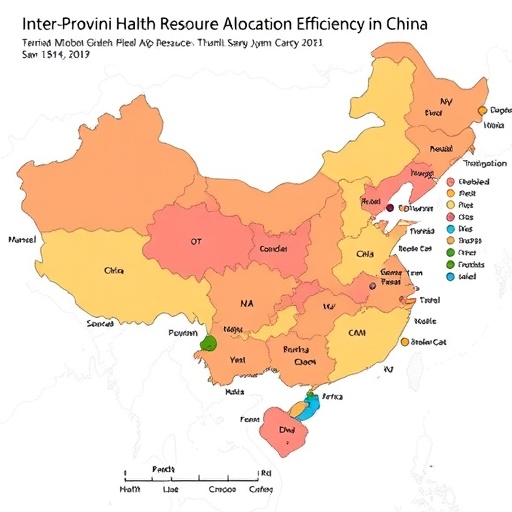In the rapidly evolving landscape of healthcare in China, the allocation of health resources across provinces has emerged as a crucial aspect of achieving equitable healthcare outcomes. A new study has shed light on the efficiency of inter-provincial health resource allocation in China, revealing intricate spatial effects and various influencing factors that could reshape how health resources are distributed in the country. The work conducted by a team of researchers spearheaded by Meng et al. aims to provide an in-depth analysis of the current state and future implications of health resource allocation across different regions, emphasizing both efficiency and equity.
The study’s findings point to significant disparities in health resource allocation efficiency among different provinces in China. These discrepancies not only affect the availability and quality of health services but also contribute to the larger question of health equity in the nation. A systematic investigation into the spatial effects highlights how geographical location influences the distribution of health resources. Urbanized provinces tend to enjoy superior health service access relative to their rural counterparts, underscoring the need for targeted policy interventions.
Additionally, the research accentuates the relationship between various socio-economic indicators and health resource allocation. Provinces with higher GDP and better infrastructure often demonstrate more efficient allocation of resources. On the flip side, less economically developed regions struggle with not just the quantity, but also the quality of health services available to their residents. This presents a dual challenge that calls for both economic support and strategic planning to enhance health service delivery in underprivileged areas.
Emphasizing the role of governance in health resource distribution, the researchers argue that provinces with more effective health policy frameworks are better positioned to optimize their resources. Administrative efficacy, transparency, and public trust emerge as key factors that influence the overall efficiency of health resource allocation. Political will and intergovernmental cooperation also play pivotal roles in aligning health needs with available resources, facilitating better health outcomes for all citizens.
Another intriguing aspect of the study is its exploration of technological advancements as a potential game-changer in health resource allocation. The adoption of data analytics and health information systems could provide a more nuanced understanding of healthcare needs by allowing provinces to make data-driven decisions. Such technologies can facilitate real-time monitoring and evaluation of health services, driving efficiency through informed policymaking.
Furthermore, the study recognizes the impact of cultural attitudes and behaviors on health resource allocation. For instance, provinces with a high prevalence of preventive health practices often experience better health outcomes. The insights gathered highlight that promoting healthcare awareness and preventive care can mitigate disparities and enhance the effectiveness of existing health resources. This indicates that health initiatives must transcend mere availability of resources and intertwine with educational efforts at promoting healthy lifestyles.
As the study delves deeper into the interplay of environmental factors with health resource allocation, it becomes apparent that elements such as geography, climate, and even demographic variations play considerable roles. Evidence is provided showcasing that provinces with challenging terrains may struggle more in allocating resources effectively, which calls for tailored solutions that accommodate unique geographical challenges.
Moreover, the implications of these findings extend beyond the national context. As China grapples with an aging population and increasing chronic diseases, the demand for efficient health resource allocation becomes more critical. Policymakers are prompted to consider innovative solutions that not only address existing disparities but also anticipate future health challenges. This foresight is crucial in building a resilient health system that can withstand both current pressures and future demands.
The researchers advocate for a comprehensive policy overhaul that incorporates both quantitative and qualitative assessments of health resource allocation. By understanding regional disparities better, government and health authorities can prioritize actions that lead to more equitable distribution of health services. The study serves as a clarion call for an integrated approach to health resource management that is adaptable and reflective of the diverse needs of the population.
In conclusion, the study undertaken by Meng et al. provides invaluable insight into the complexities surrounding inter-provincial health resource allocation in China. It emphasizes that achieving health equity is not merely a resource-centric challenge but one that requires a multifaceted approach, encompassing economic, political, technological, and cultural dimensions. As China strides towards improving its healthcare system, the findings of this research present a roadmap filled with opportunities for informed and efficient decision-making in health resource allocation.
With health equity as the ultimate goal, this study opens up new avenues for scholars, practitioners, and policymakers alike, inviting them to engage in a deeper dialogue about effective health resource management.
Subject of Research: Inter-provincial health resource allocation efficiency in China.
Article Title: The spatial effects and influencing factors of inter-provincial health resource allocation efficiency in China.
Article References:
Meng, N., Wan, Z., Chen, H. et al. The spatial effects and influencing factors of inter-provincial health resource allocation efficiency in China.
BMC Health Serv Res (2025). https://doi.org/10.1186/s12913-025-13694-6
Image Credits: AI Generated
DOI: 10.1186/s12913-025-13694-6
Keywords: health resource allocation, inter-provincial efficiency, health equity, China, socio-economic factors, governance, technology.




